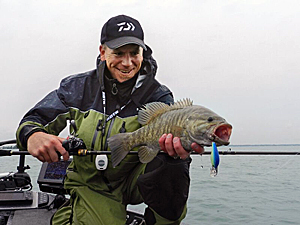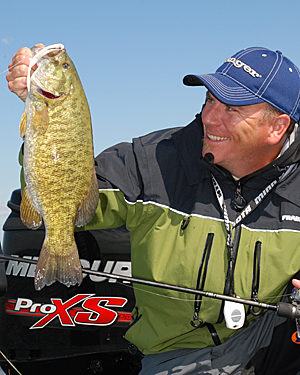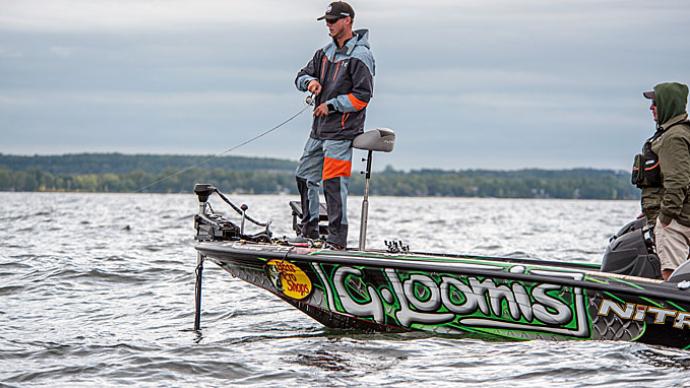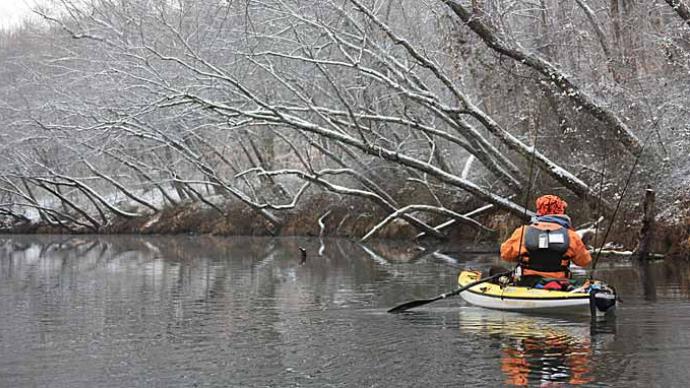
Fall is a transition time for smallmouth bass. The changes can take place over several months or a few weeks. The amount of time this transition period occurs depends on the weather. Smallmouths go from aggressively crashing spinnerbaits and herding baitfish to a dormancy level requiring painstakingly subtle presentations with specialized hair jigs to coax lethargic bass into biting. Anglers need to adapt to continue to be successful.
“September smallmouths are still extremely aggressive,” offered smallmouth guru Joe Balog. “They’re still basically in their summer patterns in September, but as soon as you see the weather changing, they will interact with those changes. Cool weather and chilly winds will dictate smallmouth's movements and changes in their preferred forage.”
Smallmouths that have been in their typical 10- to 20-foot summer haunts will often move shallow before they move deep. The reason is forage. During September and even October, smallmouths will continue to feed on bottom-dwelling forage like perch, crayfish, gobies, and other baitfish. Emerald shiners head shallow, having spent the entire summer suspended over deep water. Spot-tailed shiners, a perennial favorite of smallies wherever they are found, head shallower, too. Smallmouths are close behind.
“Shiners school on the flats and in the channels where they can find more stable water temperatures,” offered Balog. “Many times, this is in the deeper basins of marinas. The shiners will stay there until well after ice starts forming and smallmouth have left for deeper water.”
Balog said the hot early fall bite could last well into October, even in the most northern climes. “You want to cover water with spinnerbaits or lipless crankbaits then,” he said. “It’s hard to beat a spinner bait with gold double willow leaf blades. White is always a good skirt color, but it depends on the body of water. Many guys use a chartreuse skirt with painted blades and do well. It all depends on where you’re fishing. The idea is to make long casts, cover water and burn the bait. The fish are aggressive then and will catch the bait if they want it.”
The whole fall fishing scenario is weather dependent. “Even in the most northern climes, you can experience great shallow water fishing well into October,” offered Balog. But once water temperatures get into the lower 50s or 40s, smallmouths begin transitioning to their winter haunts, and the fish do so in mass.
Fall smallmouth fishing can be broken down into three distinct periods – the hot, shallow early fall bite, the transition period, and a state of winter inactivity.
Adapting techniques, smallmouth bass can be caught during all three of these periods. Balog said that some of the best fall smallmouth fishing takes place in November and December when bass are highly concentrated, but most bass fishermen have their boat in winter storage long before then.

“Late fall and early winter can produce some of the greatest smallie fishing of the year,” he said, “but for many anglers, it’s all about not being comfortable,” Balog said one of his most incredible days of smallmouth fishing occurred during a mild December reprieve when he caught five smallmouths that weighed more than 31 pounds and included a 7-pound-plus bronzeback and a 6-pound-plus giant on consecutive casts. Most anglers are home watching football then.
Once bass leave the shallows and relocate to their winter haunts, presentations go from horizontal to vertical. This is because bass will change forage preferences from bottom-dwelling species to baitfish that suspend like alewives, shad, or smelt.
“You’re going to want to go more and more vertical as the season progresses,” advised Balog. “Smallmouths will take up residence on the last available structure, whether it’s in 12 or 20 or 60 feet of water. The best way to target those fish is with a vertical presentation.
“One of the best vertical baits ever invented is the original Silver Buddy Blade baits shine in the winter. You need to take care not to overfish it, though. Just lift and drop. That little shimmy that the lure produces is enough. I use a limber rod, medium action, and 12-pound Suffix fluorocarbon.”
Bass in frigid water may require an even more subtle presentation. “When fishing for these cold-weather bass, even the most subtle changes can make a big difference,” said Balog. He told of a late fall trip when his partner spanked him 20 bass to two, and the only difference they could tell was some different colors of Krystal Flash in their hair jigs.
“Intricate details can make a big difference then,” he said. It can be head design, lures colors, or a subtle difference in presentation. “Cold-water bass are picky because they have to feed less,” advised Balog.

Balog said when in doubt, a hair jig is hard to beat during the coldest months. The subtle quiver, pulsating, and a shiver of natural hair jigs are more than even the coldest smallmouth can resist. The trick is to fish them slow enough.
Recent advances in electronics have made finding tightly schooled pods of winter bass easier to locate. “Late-season smallmouth bass are more concentrated than any other fish I know of,” claimed Balog. “You might have 50 rock piles that don’t have a single fish on them, and then find one with 100 bass around it. Features like the side imaging feature on my Humminbird Helix 10 have made finding those spots much easier.”
River smallmouths behave similarly to lake fish, going through an early fall period of heightened activity until water temps dip into the mid-50’s and lower, and bass begin seeking their winter residence.
In September, when waters are still warm, expect river smallies to be rooting out crayfish in the rocks and riffles or chasing minnows in slack-water areas. As waters chill, smallie forge in the rivers switches from 60% or 70% crayfish to more shiners and chubs. Crayfish become less active and less available as water temperatures dip. Late-season crayfish are also larger with harder shells that are less desirable to bass. By fall, young of the year, minnows have reached a good size and are the main quarry of fall bass. Minnow imitating lures like stickbaits, flukes, in-line spinners, and tube jigs excel, mainly when fished on a down and across swing.
Fall river smallies remain relatively active until the water temps reach the low 40s and below, when they too will begin a transition to search out the deep slowest pools in a given stretch of river where they can spend the winter. Smallies become extremely concentrated then. The bass from miles and miles around will concentrate in just a few pools then. Find suitable water, and you can still catch them even though they are in a state of semi-torpor.
The same hair jigs that are the ticket in open water during the coldest months work on river smallies then. The idea is to use a float for fishing them off the bottom. Just allow the hair on the jig to pulsate and quiver as it slowly drifts along the bottom. You can stack the odds by fishing in the afternoon when water temps are the warmest or watch for a period of warmer weather to turn smallies on.
Because bass are so concentrated in late fall in rivers and lakes, anglers must practice catch and release. A couple of gun-ho anglers could severely affect the smallmouth population on a river if they killed bass. Giant smallmouths caught off open-water reefs in the late season are the same bass that will be reproducing in a few short months.
BassResource may receive a portion of revenues if you make a purchase using a link above.




